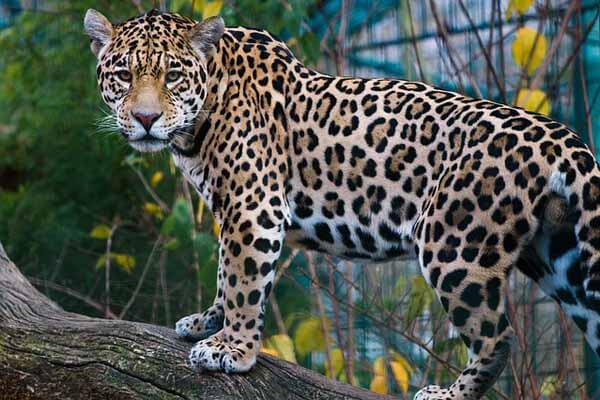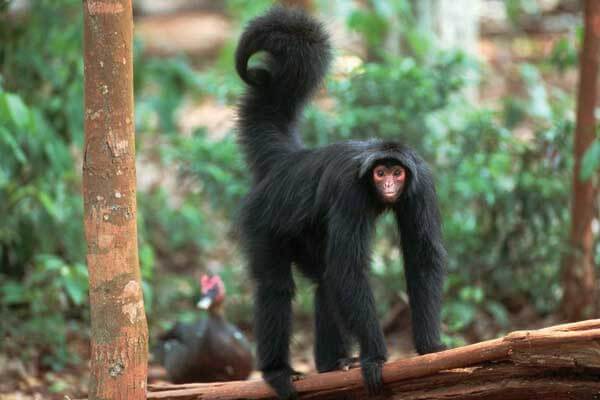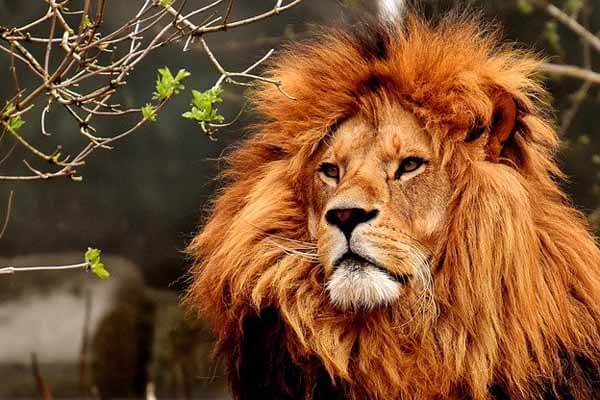In the photo – a koala (Phascolarctos cinereus) chews eucalyptus leaf in the zoo in Duisburg, Germany.
The koala bear diet consists almost exclusively of fresh eucalyptus leaves, so a rare zoo outside Australia can afford to keep these animals in captivity. Three koalas are living in Duisburg Zoo. Each of them eats 200-500 grams of leaves per day (depending on body weight, season, etc.). One eucalyptus grows right in the cage, the rest – on a plantation belonging to the zoo. Fresh branches of eucalyptus are also imported from Florida (USA) and kept in refrigerators.
In nature, the koala is used for food no more than 10% of eucalyptus species (about 700 of them are known). More than 20% of their diets are camaldulipte (Eucalyptus camaldulensis), E. microcorys, and E. tereticornis. However, despite their fastidiousness, sometimes koalas also eat tea tree leaves, acacia, allokazuarin, Callitris, and fine seeds. Some types of eucalyptus animals use it not for eating, but to sleep on them or to escape from overheating in heat (see a picture of Koala day on a tree).
Eucalyptus leaves contain a large number of secondary metabolites – phenolic compounds (such as tannins), terpenes – which can be lethal for most other mammals. Also, the leaves are very fibrous and low-calorie. So the koalas have few competitors for food resources.
The teeth and digestive system of koalas are perfectly adapted for such difficult food. They have sharp incisors that cut the leaves from the branch cutting the root teeth, and there is an interval (diastema) between the incisors and the root teeth that allows the tongue to effectively move the plant matter in the mouth. The blind gut of koalas is the longest relative to body size among mammals (of course, among those whose parameters have been studied). And the average retention time of substances passing through the gastrointestinal tract is the longest recorded for mammals. This allows for the effective digestion of food. The blind intestine is inhabited by bacteria that ferment porridge from the leaves (cellulose and lignin, the cleavage components of the cell wall), facilitating further digestion. Young koalas receive useful microflora by eating special fecal secretions from their mothers – perhaps that’s why the bag of koalas opens back for convenience.
Since the eucalyptus diet is low-calorie, koalas save energy and sleep up to 22 hours a day (so it was great luck for us to see koalas awake in the zoo: they ate, moved through the branches, looked at us). But they do not need to spend time looking for water (except for particularly hot weather): it is contained in sufficient quantities in the leaves of eucalyptus. Its reabsorption occurs in the distal (distant) part of the colon.
Koala is fussy not only in the choice of eucalyptus species (different species contain different amounts of toxic substances) but also in the choice of specific trees: eucalyptus leaves may contain different amounts of toxins depending on the soil on which the tree grows. Variety also manifests itself in the choice of leaves: koalas prefer leaves with a high ratio of nitrogen to fiber and tannins, containing at least 55% water. To choose the right leaf, the koala first sniffs and tastes it.
But how does the smell and taste of koala determine the content of the right substances and how does it neutralize toxins that are deadly to other mammals? The recent decoding of the koala genome has helped to answer these questions. Six genes of type 1 vomeronasal receptor (Vomeronasal receptor, V1R) were found, which are responsible for differentiating secondary plant metabolites. Duplication of the gene encoding Aquaporin 5 protein helps to recognize the “taste of water” and determine its content. Koalas have 24 genes of the TAS2R family (Taste receptor type 2) responsible for recognizing the bitter taste (which gives terpenes and phenols) – this is more than any other Australian marsupial!
Finally, the ability to detoxify substances in the eucalyptus leaves is due to genes encoding cytochrome P450 monooxygenase (CYP) – enzymes that oxidize toxic compounds, making them safe and easy to remove from the body. These genes are larger than many other animals. Their expression is especially high in the liver, where various substances are detoxified. Unfortunately, cytochromes also break down non-steroidal anti-inflammatory drugs, which are used to treat koalas in captivity or veterinary clinics after traffic accidents (wild koalas are often hit by cars), as well as antibiotics, which treat chlamydia, a common disease in wild koalas.
The Koala Bear Diet
If you’re interested in knowing more about the koala bear diet, you need to understand the way that koalas live. The koala is an herbivore, meaning that it only eats plants. While they don’t eat a large variety of foods, their diet is actually more varied than that of other marsupials. The three main plant types that koalas eat are eucalyptus leaves, figs, and twigs.
Koalas mainly eat eucalyptus leaves during the day, eating about 500 grams a day. They also eat Acacia, Melaleuca, and Leptospermum leaves, but they don’t prefer these over other species. However, koalas do enjoy the taste of eucalyptus trees, and they sometimes eat them as well.
Despite the low nutrient content of eucalyptus leaves, koalas consume more than one pound of plant material per day. These animals spend four to five hours per feeding session, and they eat approximately 500 grams (18 oz) of plant material per night. They eat large amounts of eucalyptus leaves because they are able to climb them vertically on the trunks.
Since their diet is relatively low in nutrients and energy, the koala bear’s diet is low in nutrients. It doesn’t provide much spare energy, and they spend long hours in tree forks sleeping and resting. Their lungs are insulated by thick fur, and they produce loud hollow grunts to help regulate their temperature. They can retain their energy for a long time because of their slow metabolic rate.
While koalas are not a predator, they shouldn’t be handled. They can cause severe injury if they are threatened. Just remember to be careful around koalas. They are lovable, but never try to touch them. They’re harmless but not to be petted! They’re also incredibly dangerous. They can bite and injure humans.
Koalas only eat leaves, which contain fiber, but they don’t have enough energy. Unlike other species, koalas have a low metabolism, but they eat enough leaves to live for the rest of their lives. They spend most of the day sleeping and if they do get up, they’ll spend 16 to 18 hours inactive, and rarely move. In order to conserve energy, they sleep in trees.
Although koalas eat a wide variety of plants, a major part of their diet consists of eucalyptus leaves. These plants are extremely nutritious but are high in sugar and salt. They can consume up to 500 grams of eucalyptus leaves each day. The koala’s forepaws are designed to chop the leaves and eat them.
The koala’s diet is incredibly nutritious, but it’s also very fibrous and low in nutrients. Its diet consists primarily of eucalyptus leaves, which contain a large proportion of the animal’s daily calories. While it sounds like a delicious diet, it’s not good for your health. Because of this, the koala should not be handled. It can be very dangerous and may bite you.
The koala’s diet consists almost entirely of eucalyptus leaves, but it also eats other plants, including tallowwood. During the day, it consumes approximately 500 grams of eucalyptus leaves. Other types of eucalyptus include acacia, eucalyptus, and bamboo. Despite the fact that they eat mostly eucalyptus, koalas do not have a lot of spare energy.
While koalas aren’t true “bears,” their diet does not involve meat. Instead, they eat eucalyptus leaves. Their diet is made up of two-thirds of eucalyptus leaves. The koalas live on the zoo’s plantation, but it is also imported from Australia. The zoo’s eucalyptus leaves come from a variety of different trees that are harvested in Florida.
While the koala bear diet is largely based on eucalyptus leaves, it is important to note that it also eats other plant species. Their food, in particular, is not very varied. They are largely dependent on eucalyptus trees, and their caecum organ is the best organ to detoxify eucalyptus leaves.








